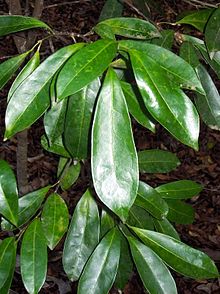Fontainea
| Fontainea | ||||||||||||
|---|---|---|---|---|---|---|---|---|---|---|---|---|

|
||||||||||||
| Systematics | ||||||||||||
|
||||||||||||
| Scientific name | ||||||||||||
| Fontainea | ||||||||||||
| Heckel |
The genus Fontainea is a genus of plants within the milkweed family (Euphorbiaceae). The nine or so species are common in Australasia .
description


Fontainea species grow as shrubs or small trees . The plant contains a colorless milky sap . The plant parts are mostly bare. The buds are finely hairy. The alternate, stalked leaves are divided into a petiole and a leaf blade. The petiole is usually significantly thickened at the upper end. The leaf blade pinnate simply or in one piece. At the lower end of the underside of the leaf there are two translucent glands that can be seen with a magnifying glass. The stipules are only tiny or absent.
Fontainea species are mostly dioecious, separate sexes ( diocesan ). They form terminal or lateral, racemose , short inflorescences . With a diameter of less than 8 millimeters, the relatively small, always unisexual flowers are four to six-fold with a double flower envelope . The four to six hairy sepals are fused cup-shaped and the four to six calyx teeth are only short. The four to six free petals are hairy on both sides. The ring-shaped disc is fleshy. Male flowers usually contain 18 to 24 stamens , the upwardly curved stamens of which are fused at their base. In the female flowers are three carpels to dreikammerigen, mostly hairy ovary grown, with only one ovule per ovary chamber. The three branches of the style are fused at their base and end in deep double-lobed scars .
The stone fruit is more or less fleshy. The endocarp is hard and has two or three, rarely more, longitudinal ridges. The fruit is single-fan and single; the other two ovules are crushed on the inner wall of the endocarp during fruit development.
Systematics and distribution
The genus Fontainea was established in 1870 by Éouard Marie Heckel in Etude au point de vue botanique et thérapeutique sur le Fontainea pancheri (nobis) , p. 9. The type species is Fontainea pancheri (Baill.) Heckel.
The genus Fontainea belongs to the tribe Codiaeeae in the subfamily Crotonoideae within the family Euphorbiaceae .
There are six species in the Australian states of Queensland and New South Wales , one species in New Caledonia and Vanuatu , and two species in Papua New Guinea .
There are about nine species in the genus Fontainea :
- Fontainea australis Jessup & Guymer : This rare endemic thrives in the rainforest just northwest of Tyalgum in New South Wales and may also be found in Queensland. It is classified as "vulnerable" = "at risk".
- Fontainea borealis P.I. Forest. : It occurs in Papua New Guinea.
- Fontainea fugax P.I. Forest. : It occurs only in the Burnett District in Queensland.
- Fontainea oraria Jessup & Guymer : This rare endemic thrives in the low-lying coastal rainforest near Lennox Head in New South Wales. It is rated as “Critically Endangered” = “threatened with extinction”. There are only 55 specimens left in the wild, only 10 of them are of flowering age.
- Fontainea pancheri (Baill.) Heckel : It occurs in New Caledonia including the Loyalty Islands .
- Fontainea picrosperma C.T.White : It occurs only on the Atherton Tableland in northeast Queensland.
- Fontainea rostrata Jessup & Guymer : It is only found in southeastern Queensland.
- Fontainea subpapuana P.I. Forest . : It occurs in Papua New Guinea.
- Fontainea venosa Jessup & Guymer : It occurs only southwest of Beenleigh in Queensland.
use
The bioactive ingredients of Fontainea species were isolated and their medicinal effects were investigated. The ingredient EBC-46 (contained in Fontainea species and Hylandia dockrillii ) showed an effect on cancer cells in laboratory tests.
swell
- TA James, GJ Harden: Fontainea datasheet at New South Wales online .
Individual evidence
- ↑ a b c d e TA James, GJ Harden: Fontainea data sheet at New South Wales online .
- ^ Fontainea at Tropicos.org. Missouri Botanical Garden, St. Louis, accessed November 5, 2014.
- ^ Fontainea in the Germplasm Resources Information Network (GRIN), USDA , ARS , National Genetic Resources Program. National Germplasm Resources Laboratory, Beltsville, Maryland. Retrieved November 5, 2014.
- ↑ a b c d e f g Rafaël Govaerts (Ed.): Fontainea. In: World Checklist of Selected Plant Families (WCSP) - The Board of Trustees of the Royal Botanic Gardens, Kew . Retrieved November 5, 2014.
- ↑ a b c d e f Fontainea data sheet at Australian Plant Name Index = APNI.
- ^ NSW Department of Environment and Climate Change .
- ↑ Victoria Gordon et al .: Blushwood vs. Cancer : Full text online.